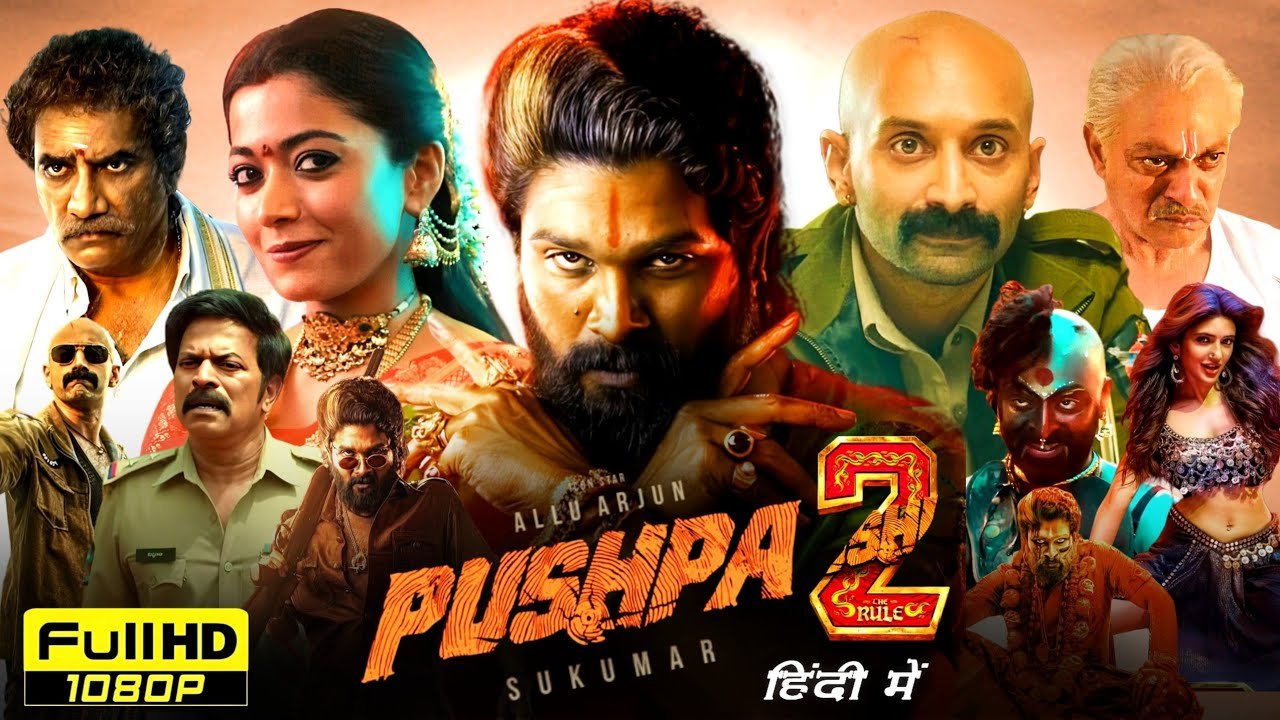Pushpa 2: The Rule” is a Telugu-language action crime drama written and directed by Sukumar, starring Allu Arjun as Pushpa Raj, alongside Rashmika Mandanna and Fahadh Faasil as SP Bhanwar Singh Shekhawat. It debuted theatrically on 5 December 2024 across multiple languages including Telugu, Hindi, Tamil, Kannada, Malayalam, and Bengali. IMAX, 4DX, D‑Box, and ICE formats were included, while the 3D version released later on 13 December.
🎬 Plot Intent & What to Expect
The sequel follows Pushpa as he cements his position at the top of the red-sandalwood smuggling empire while clashing with Fahadh Faasil’s fiercely intense cop. Audiences will find more larger-than-life action set pieces and mass-audience drama than the more grounded Rise installment. The trailer highlighted Pushpa’s transformation into a “brand” and teased a dramatic showdown between hero and villain.

[table id=4 /]
🌍 Box Office & Bluray Success
The film shattered records, grossing nearly ₹1 830 crore (about US $210 million) worldwide, becoming India’s highest-grossing film, and topping charts in seven northern states. Its international reach spanned over 12 000 screens globally
📣 Audience & Critical Response
The trailer exploded online amassing 120 million YouTube views and over 2.3 million likes. Netizens praised Allu Arjun’s swagger and Fahadh Faasil’s entrance, though some felt the trailer leaned too much into grandeur, with a few calling parts “cringe”.
On Reddit, fans expressed mixed reviews:
“It was good okay, but wasnt as captivating or story enriched like part 1″
“Movie is filled with unnecessary fight scenes and fillers… lacks a strong villain”
Some critics echoed these thoughts, criticizing the script as chaotic and plot-light, though Allu Arjun’s performance and certain set pieces stood out .
🧩 Standout Action Scenes
A climactic fight sequence went viral: Pushpa, tied up in a sari, uses his teeth and body to defeat multiple enemies in cinematic slow-motion dubbed by Netflix as one of the most creative and thrilling fights of 2024. Critics called it an unforgettable spectacle showcasing the film’s mass-appeal energy .
📺 Streaming Details
After dominating theaters, “Pushpa 2” began streaming in its Reloaded version on Netflix from 5 February 2025. Earlier, North American theatrical rights were reportedly sold for a record US $7.4 million. Its Hindi TV premiere was scheduled on Zee Cinema on 31 May 2025.
🧠 Final Verdict
Pushpa 2 is a high-voltage mass entertainer, filled with spectacle and star-power, though critics say it trades nuanced storytelling for relentless action and hero worship. It’s a film for audiences who loved the first and crave extra adrenaline, but viewers wanting a richer narrative might feel the edge blunt.
Storytelling Of Pushpa 2: The Rule (2024)
After rising from the dirt and betrayal of Part 1, Pushpa Raj is no longer just a red sandalwood smuggler he’s a symbol of rebellion. He has territory, followers, swagger. His enemies now whisper his name with fear. But with greater power comes deeper danger.
The film opens with a rumor that Pushpa is dead. The police claim he was shot while fleeing. But before anyone can react, a video surfaces. It shows Pushpa alive, hiding among tribal people, now treated like a deity. He walks into the frame with a wild tiger beside him. The message is loud: Pushpa has returned not as a man, but as a legend.
This act triggers a political and police crisis. SP Bhanwar Singh Shekhawat the cunning, brutal officer from the first part is enraged. He swore to break Pushpa’s pride, and now he’s humiliated. Their personal war becomes institutional. Bhanwar Singh gets clearance to lead a full-scale operation against Pushpa.
We dive deeper into Pushpa’s empire. The red sandalwood network has expanded. Pushpa is more of a don than a smuggler now running everything from the shadows. His trusted men, like Keshava, manage shipments, bribery chains, and transportation across borders. But cracks begin to appear. Rivals rise. Inside betrayal looms.
Meanwhile, Pushpa struggles to protect Srivalli, his wife. Their love is still strong, but the constant threats have changed their bond. Srivalli wants safety, a life for their unborn child. Pushpa, though, is consumed with legacy. He doesn’t want to escape he wants to rule.
Then comes the first major betrayal. A group within Pushpa’s syndicate is secretly colluding with Shekhawat. A trap is laid. Pushpa walks into it and gets captured. What follows is a brutal sequence. Shekhawat humiliates him publicly, parades him through town, trying to break the myth of Pushpa.
But Pushpa doesn’t break. He smiles in his chains. And then, he escapes in a scene that becomes an instant legend using nothing but fire, mud, and animal instinct. It’s not just an escape it’s a resurrection.
From here, the story takes a more personal turn. Pushpa returns to avenge the betrayal from within. One by one, he hunts the traitors in his camp. The punishment is swift and severe. But his vengeance isn’t loud it’s symbolic. In one scene, he burns a red sandalwood log in front of a traitor’s home, marking the house as cursed.
Now, the final confrontation builds. Pushpa challenges Shekhawat not with guns, but with tactics. He turns Shekhawat’s own men, plays political allies against him, and exposes his corruption in the media. The game flips Shekhawat becomes the hunted. His fall is dramatic, not just physical but psychological.
In the final act, Pushpa and Shekhawat face off in a rain-drenched forest no backup, no men, just their raw hatred. The fight is primal. There is no music. Just breath, fists, and blood. Pushpa emerges victorious — not by killing Shekhawat, but by sparing him and leaving him alive in disgrace.
The closing scenes show Pushpa crowned in silence. His enemies defeated. His people cheering. But his eyes? Still restless. Because Pushpa knows power is never permanent. The crown he wears is soaked in blood, betrayal, and burden.
Key Themes Woven Into the Story:
-
Survival vs Power: Pushpa evolves from a survivor to a ruler, but ruling is lonelier and more dangerous.
-
Mythmaking: The film explores how criminals become gods in the eyes of the people.
-
Masculinity and Pride: Both Pushpa and Shekhawat are obsessed with dominance but Pushpa’s pride is internal, while Shekhawat’s is performative.
-
Class warfare: Pushpa remains a representative of the oppressed class, outsmarting the elite using his street wit.

